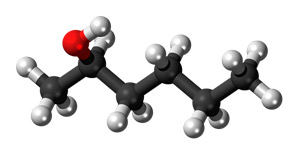|
Home
Carbon
 Carbon, possessing four electrons in its outer
shell, is in group(IVA) of the periodic table. Carbon, possessing four electrons in its outer
shell, is in group(IVA) of the periodic table.
Its electronic configuration is 1s22s22p2.
The four electrons are used in covalency with themselves and with atoms of other
elements, such as hydrogen, oxygen, chlorine, nitrogen and sulphur.
Therefore, carbon is tetravalent.
Molecular structure of carbon
showing the
phenomenon catenation.
All compounds of carbon, with the exception of
the simpler compounds such as carbon(IV) oxide and sodium trioxocarbonate (IV)
are regarded as organic compounds. Compounds of Carbon
Carbon forms many compounds (many of them are
complex), because:
- Carbon atoms can combine with one another to form long continuous chains
or ring compounds containing many carbon atoms, hence it is possible to find
organic compounds of very high relative molecular masses (up to 50,000) - this
phenomenon is known as catenation. Besides carbon, sulpur and silicon can also
catenate.
- Carbon combines with hydrogen, oxygen, nitrogen and the halogens with almost
equal ease, forming wide range of compounds.
- Carbon can combine with the same elements, but in different arrangement of
their atoms within a molecule. I.e., compounds of different structural forms are
formed.
- Two adjacent carbon atoms can be linked by a single, double or triple bonds,
resulting in the formation of different compounds.
Hybridization of CarbonHybridization is the phenomenon whereby different atomic orbitals (of different
energies) of the same shell mix up to form orbitals of equal energies.
These orbitals (i.e. the hybridized orbitals) take part alike in chemical bonding with
orbitals of other atoms. In carbon, the s and p orbitals of the second shell
(i.e. 2s and 2p) can mix up to different degrees, forming different types of
hybridization.
Therefore, carbon can form different compounds using different
hybridization.
|